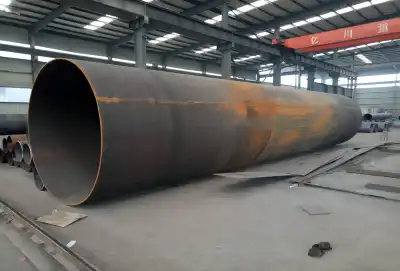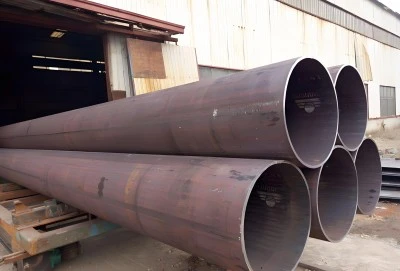Longitudinal Submerged Arc Welded (LSAW) steel pipes are crucial components in various industries, including oil and gas, construction, and infrastructure. The thickness of these pipes plays a vital role in determining their strength, durability, and suitability for specific applications. In this comprehensive guide, we'll explore the thickness range of LSAW steel pipes, how it's determined, typical ranges, and the impact of different standards on thickness specifications.
|
|
|
What is the thickness range of LSAW steel pipe?
LSAW steel pipes are known for their versatility in thickness, accommodating a wide range of requirements for different projects. The thickness of LSAW pipes typically ranges from 6mm to 150mm (0.236 inches to 5.91 inches). This extensive range allows for the production of pipes suitable for various pressure ratings and environmental conditions.
The lower end of the thickness spectrum, around 6mm to 12mm, is often used for applications with moderate pressure requirements or in less demanding environments. These thinner-walled pipes are lighter and more cost-effective, making them suitable for water transportation systems or low-pressure gas lines.
On the other hand, thicker LSAW pipes, ranging from 50mm to 150mm, are designed for high-pressure applications and harsh environments. These pipes are commonly used in offshore oil and gas pipelines, where they must withstand extreme pressures and corrosive conditions.
It's important to note that while the theoretical range extends to 150mm, practical limitations in manufacturing and transportation often cap the maximum thickness at around 100mm for most applications.
How is the thickness of LSAW steel pipe determined?
- Internal Pressure: The primary factor in determining pipe thickness is the internal pressure the pipe must withstand. Higher pressures require thicker walls to prevent burst failures.
- External Loads: Pipes buried underground or used in offshore applications must resist external pressures from soil, water, or other environmental factors.
- Material Properties: The strength and ductility of the steel used affect the required thickness. Higher-grade steels may allow for thinner walls while maintaining the necessary strength.
- Safety Factors: Engineers incorporate safety factors into thickness calculations to account for uncertainties and ensure a margin of safety.
- Corrosion Allowance: In corrosive environments, additional thickness is added to account for material loss over the pipe's lifespan.
- Manufacturing Tolerances: Thickness calculations must account for potential variations in the manufacturing process.
The thickness is typically calculated using established formulas and standards, such as those provided in API 5L or ASME B31.3. These calculations consider the pipe's diameter, design pressure, material yield strength, and various safety factors.
For example, the Barlow's formula is often used as a starting point for calculating the minimum required thickness:
t = (P * D) / (2 * S * E)
Where: t = minimum required thickness P = internal design pressure D = outside diameter of the pipe S = allowable stress in the pipe material E = joint efficiency factor
This basic formula is then modified and expanded upon in various standards to account for additional factors and specific application requirements.
What are the typical thickness ranges of LSAW pipes?
While LSAW steel pipes can be manufactured across a broad thickness range, certain ranges are more common in specific applications:
- 6mm - 20mm: Commonly used for water transportation, low-pressure gas lines, and some structural applications.
- 20mm - 40mm: Suitable for moderate-pressure oil and gas pipelines, both onshore and offshore.
- 40mm - 60mm: Often used in high-pressure transmission pipelines and challenging offshore environments.
- 60mm - 100mm: Reserved for extreme high-pressure applications, deep-water pipelines, and specialized industrial uses.
It's worth noting that these ranges are not strict categories but rather general guidelines. The exact thickness chosen will depend on the specific project requirements and the results of detailed engineering calculations.
For instance, in the oil and gas industry, LSAW pipes with thicknesses between 15mm and 50mm are particularly common for trunk pipelines. These pipes offer a good balance between strength, weight, and cost-effectiveness for long-distance transportation of hydrocarbons.
How do different standards affect the thickness range of LSAW pipes?
Various international and regional standards govern the manufacturing and use of LSAW steel pipes. These standards can significantly impact the allowable thickness ranges and the methods used to determine appropriate thicknesses. Some of the most influential standards include:
- API 5L: This American Petroleum Institute standard is widely used in the oil and gas industry. It specifies two product specification levels (PSL 1 and PSL 2) with different requirements for chemical composition, mechanical properties, and non-destructive testing. API 5L allows for a wide range of thicknesses but places more emphasis on the pipe's ability to withstand specific pressures rather than mandating specific thickness ranges.
- ISO 3183: This international standard is harmonized with API 5L and provides similar guidelines for pipe manufacturing and testing. It covers a broad range of thicknesses and is widely recognized globally.
- ASTM A1018: This American Society for Testing and Materials standard covers high-strength low-alloy steel plate, which is often used in LSAW pipe production. It indirectly affects thickness ranges by specifying material properties that influence thickness calculations.
- DNV-OS-F101: Developed by Det Norske Veritas, this standard is specifically for submarine pipeline systems. It provides detailed guidelines for thickness calculations, particularly for offshore applications where external pressures and environmental factors play a significant role.
These standards not only affect the allowable thickness ranges but also influence the testing and quality control procedures used in pipe manufacturing. For example, API 5L and ISO 3183 specify different hydrostatic test pressures based on the pipe's diameter, thickness, and grade, ensuring that pipes meet the required pressure ratings.
It's important to note that while these standards provide guidelines, the final thickness selection often involves a combination of standard requirements, engineering calculations, and practical considerations specific to each project.
Contact Information
The thickness range of LSAW pipes is a critical factor in their performance and suitability for various applications. From thin-walled pipes used in water transportation to ultra-thick pipes designed for deep-sea oil extraction, LSAW technology offers a versatile solution for diverse industrial needs.
Understanding the factors that influence thickness determination, typical ranges, and the impact of different standards is crucial for engineers, project managers, and procurement specialists working with LSAW pipes. By carefully considering these aspects, it's possible to select the optimal pipe thickness that balances safety, performance, and cost-effectiveness.
For more information on LSAW steel pipes and how they can benefit your project, don't hesitate to reach out to our team of experts. We're here to help you find the perfect pipe solution for your specific needs. info@longma-group.com to discuss your steel pipe requirements and discover how we can support your project's success.














